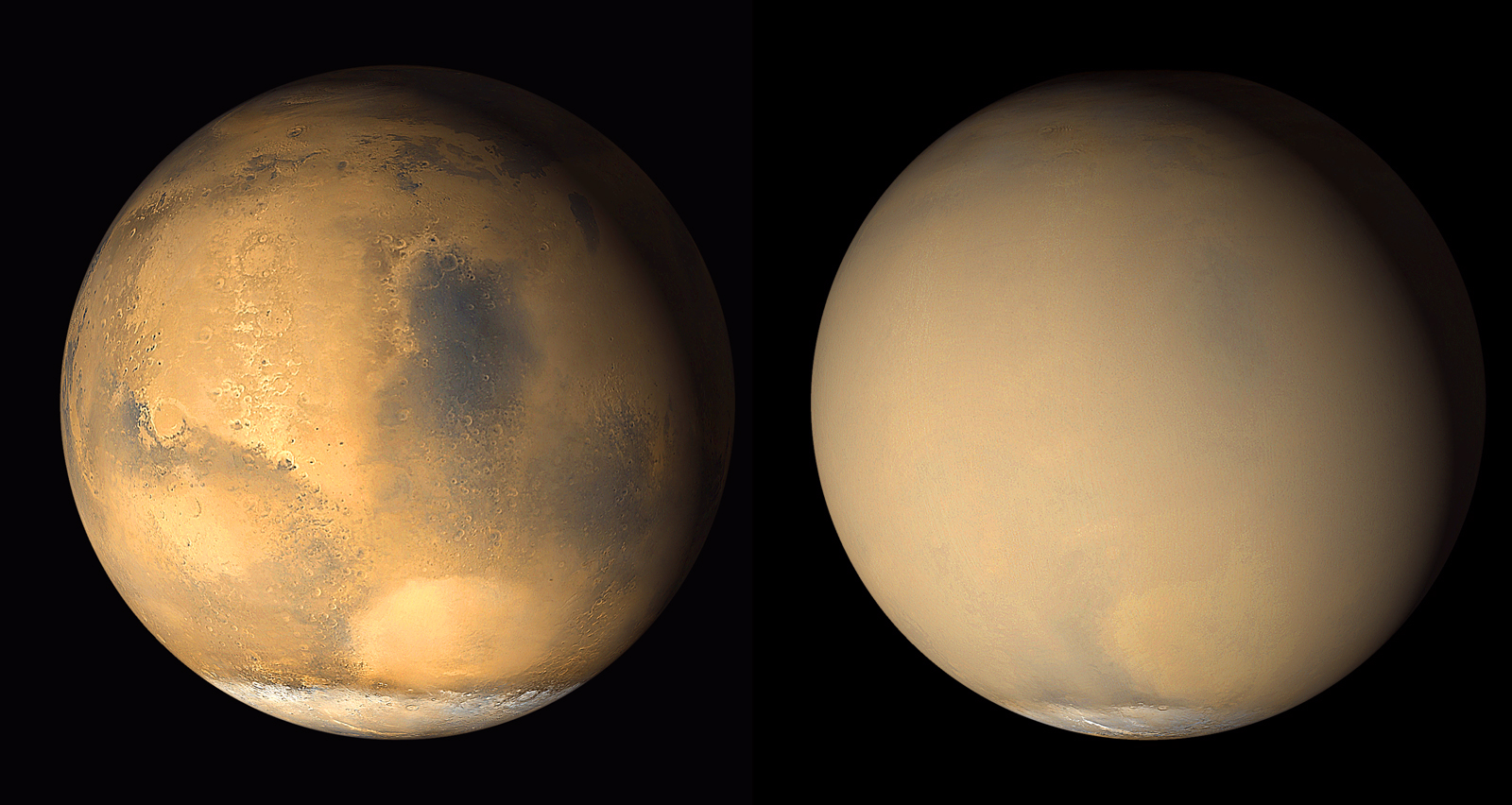Mars Global Surveyor
Technology
The Mars Global Surveyor team implemented four innovative procedures that enabled their spacecraft to return more science data than all previous Mars missions combined.

Technologies of Broad Benefit
Propulsion: Two innovations minimized propulsion usage, allowing Mars Global Surveyor to successfully operate at Mars for more than eight years, conducting long-term studies all the while.
1. Angular Momentum Management Plan
As Mars Global Surveyor orbited the Red Planet, the force of gravity from the uneven terrain below tugged and pushed the spacecraft. Mountains and valleys caused the spacecraft to fly in a non-circular orbit at slightly varying altitudes. The effect was similar to turbulence in an airplane.
Early in the mission, Mars Global Surveyor used small thrusters to adjust the reaction wheels and keep the spacecraft from drifting off course or off balance. With the angular momentum management plan, the spacecraft balanced itself naturally, without needing as much fuel to fight the external forces of gravity. For example, instead of pointing straight down, the spacecraft was tilted backward 16 degrees, which helped distribute the gravitational pull of the planet more evenly on the body of the spacecraft and cut fuel consumption by 800%.
2. Aerobraking
To reduce the mass and expense of fuel needed for the mission, the Mars Global Surveyor team used a braking technique called aerobraking to trim the spacecraft's initial, highly elliptical orbit into a nearly circular orbit after arriving at Mars. The aerobraking technique eliminated the need for 3,300 pounds (1,500 kilograms) of braking propellant during the 435-million-mile (700-million-kilometer) interplanetary journey to Mars. The lighter weight reduced the size of the launch vehicle required from a Titan III to a Delta rocket, saving $250 million.
The Magellan spacecraft at Venus was the first planetary spacecraft to use aerobraking, in a demonstration in 1993. Its success cleared the way for the use of aerobraking by Mars Global Surveyor. And the success of Mars Global Surveyor's aerobraking paved the way for Odyssey and Mars Reconnaissance Orbiter to use the same technique.
Science Instruments
Remote Science Instrumentation: Two other innovations changed how the spacecraft was flown, to increase its ability to collect science data from Mars.
1. Image Motion Compensation
Starting in 2003, the camera and spacecraft teams for Mars Global Surveyor perfected a technique that allowed the entire spacecraft to roll so that the camera could scan surface details at three times higher resolution than if the spacecraft did not roll. The image motion compensation technique adjusted the spacecraft's rotation rate to match the ground speed under the camera.
For several years, the Mars Orbiter Camera acquired the highest-resolution images ever obtained from a Mars-orbiting spacecraft. During normal operating conditions, when the spacecraft did not roll, the smallest objects that could be resolved on the Martian surface were about 13 to 16 feet (4 to 5 meters) across. With the adjusted-rotation technique, called "compensated pitch and roll targeted observation" or "CPROTO," objects as small as 4.9 feet (1.5 meters) were visible in images from the same camera. Resolution capability of 4.6 feet (1.4 meters) per pixel was improved to 1.7 feet (one-half meter) per pixel.
2. Beta Supplement
A vital component of collecting science data is the ability to send the information to Earth. The High Gain Antenna was a dish antenna that sent and received data at high rates. To communicate with NASA's Deep Space Network antennas, it had to point toward Earth.
In 1997, after Mars Global Surveyor begin orbiting Mars, investigators realized that the antenna's range of motion was surprisingly limited. When the spacecraft was in certain positions, they were unable to adjust the antenna to point it directly toward Earth. The team discovered that the problem stemmed from a loose screw that most likely vibrated out of position during launch.
To maximize science return, the team figured out a way to flip-flop the antenna during every 2-hour orbit. This flip-flop, officially named the "Beta Supplement," provided two 25-minute intervals for communicating with Earth during each orbit. The flip-flop or rewind of the antenna was a complex operation, as can be seen in the Beta Supplement Animation.
While the antenna had to point toward Earth for communications, the solar panels had to point toward the Sun for energy, and the science instruments had to point toward Mars to collect data. The Mars Global Surveyor team creatively twisted and turned the spacecraft during each revolution about Mars to accommodate all of these needs.




